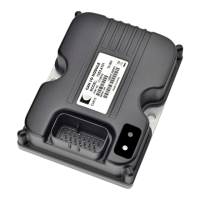5 — SDO COMMUNICATIONS
Curtis 1353 CANopen Expansion Module Manual – June 2017 Return to TOC
pg. 28
Store Parameter Object
e Store Parameter Object controls when and if the changes made to the Object Dictionary (by
SDO Write) are moved (stored) into EEPROM. An SDO read of the Save All Parameters sub-index
0x01 will return the present EEPROM Storage functionality. An SDO write to this sub-index is used
to change the EEPROM Storage functionality. Note that the Save Type is always saved to EEPROM
(even the No_Save option) so that the 1353 will power up in the desired mode.
e text strings “save” and “bkup” initiate a complete storage of all parameters to either the Normal
EEPROM space or the Backup EEPROM space.
Table 2b Store Parameter Object
Function Request Value RW Description
SET_NO_SAVE 0 RW
Device will not save parameter changes to EEPROM.
SET_SAVE_ON_COMMAND 1 RW Device will save parameter changes to EEPROM on
command.
SET_AUTO_SAVE 2 RW Device will save parameter value to EEPROM
automatically upon the SDO Write request.
SET_BOTH_SAVE 3 RW Changes are saved on command and also
automatically.
SAVE_COMMAND “save”
0x65766173
RO Text string that commands all parameters to be
saved from working RAM to normal EEPROM space.
BACK_UP_COMMAND “bkup”
0x70756B62
RO Text string that commands all parameters to be
saved from working RAM to the Backup EEPROM
space. Not that this function works independent of
the Save type setting (even No_Save).
At rst glance, the ASCII looks “backward.” is is because CANopen denes that the LSB goes rst
and MSB is sent last. erefore “save” (which is data bytes 5, 6, 7, and 8) is written as “evas” when
converting it to hex (data bytes in proper descending order). Using the ASCII hex values for each
character, we get 65h (“e”), 76h (“v”), 61h (“a”), and 73h (“s”) for the nal resultant hex6 byte number
of 0x 65766173.
A text string is required (by DS301) for the SAVE_COMMAND to increase security. On reception
of the correct string, the 1353 stores the parameters and then conrms the SDO transmission. If the
storing failed, the 1353 responds with an Abort SDO. If a wrong string or unsupported command is
written, the 1353 will not store and responds with an Abort SDO.
e “save” string will cause the 1353 to write all RW parameters from the Working RAM locations
into the Normal EEPROM locations. e Normal EEPROM block is accessed during standard SDO
write requests.
e “bkup” string will write into the secondary Backup EEPROM block. is block is not written to
by normal SDO write requests and can only be accessed by the “load” command.
Note that of these six requests, only “save” is dened by DS301; the others are Curtis extensions.

